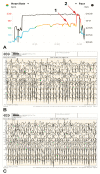Exercise-Induced Arrhythmia or Munchausen Syndrome in a Marathon Runner?
- PMID: 37761288
- PMCID: PMC11340689
- DOI: 10.3390/diagnostics13182917
Exercise-Induced Arrhythmia or Munchausen Syndrome in a Marathon Runner?
Abstract
A 36-year-old professional marathon runner reported sudden irregular palpitations occurring during competitions, with heart rates (HR) up to 230 bpm recorded on a sports HR monitor (HRM) over 4 years. These episodes subsided upon the cessation of exercise. Electrocardiograms, echocardiography, and cardiac magnetic resonance imaging results were borderline for athlete's heart. Because an electrophysiology study and standard exercise tests provoked no arrhythmia, doctors suspected Munchausen syndrome. Ultimately, an exercise test that simulated the physical effort of a competition provoked tachyarrhythmia consistent with the HRM readings. This case demonstrates the diagnostic difficulties related to exercise-induced arrhythmia and the diagnostic usefulness of sports HRMs.
Keywords: Munchausen syndrome; arrhythmia; artifacts; athlete’s heart; endurance running; exertion rhythm disorders; heart rate monitor; tachycardia.
Conflict of interest statement
The authors declare no conflict of interest.
Figures




Similar articles
-
Heart Rate Monitor Instead of Ablation? Atrioventricular Nodal Re-Entrant Tachycardia in a Leisure-Time Triathlete: 6-Year Follow-Up.Diagnostics (Basel). 2020 Jun 10;10(6):391. doi: 10.3390/diagnostics10060391. Diagnostics (Basel). 2020. PMID: 32532026 Free PMC article.
-
The "athlete's heart" features in amateur male marathon runners.Cardiol J. 2021;28(5):707-715. doi: 10.5603/CJ.a2019.0110. Epub 2020 Jan 7. Cardiol J. 2021. PMID: 31909474 Free PMC article.
-
Are heart rate monitors valuable tools for diagnosing arrhythmias in endurance athletes?Scand J Med Sci Sports. 2018 Feb;28(2):496-516. doi: 10.1111/sms.12917. Epub 2017 Jun 16. Scand J Med Sci Sports. 2018. PMID: 28543790
-
The athlete's heart. Part II: influencing factors on the athlete's heart: types of sports and age (review).Acta Physiol Hung. 2013 Mar;100(1):1-27. doi: 10.1556/APhysiol.100.2013.1.1. Acta Physiol Hung. 2013. PMID: 23471039 Review.
-
The athlete's heart is a proarrhythmic heart, and what that means for clinical decision making.Europace. 2018 Sep 1;20(9):1401-1411. doi: 10.1093/europace/eux294. Europace. 2018. PMID: 29244075 Review.
Cited by
-
Particular Aspects of Cardiac Rhythm Disorders in Pediatric Patients.Children (Basel). 2025 Jan 22;12(2):117. doi: 10.3390/children12020117. Children (Basel). 2025. PMID: 40003221 Free PMC article.
References
-
- Graziano F., Juhasz V., Brunetti G., Cipriani A., Szabo L., Merkely B., Corrado D., D’ascenzi F., Vago H., Zorzi A. May Strenuous Endurance Sports Activity Damage the Cardiovascular System of Healthy Athletes? A Narrative Review. J. Cardiovasc. Dev. Dis. 2022;9:347. doi: 10.3390/jcdd9100347. - DOI - PMC - PubMed
-
- La Gerche A., Claessen G., Dymarkowski S., Voigt J.-U., De Buck F., Vanhees L., Droogne W., Van Cleemput J., Claus P., Heidbuchel H. Exercise-induced right ventricular dysfunction is associated with ventricular arrhythmias in endurance athletes. Eur. Heart J. 2015;36:1998–2010. doi: 10.1093/eurheartj/ehv202. - DOI - PubMed
Publication types
LinkOut - more resources
Full Text Sources

